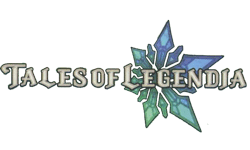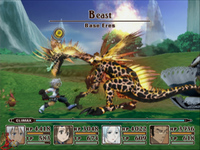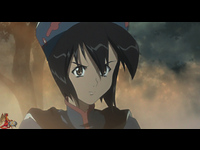|
|

|
BATTLE SYSTEM
|

|
INTERACTION
|

|
ORIGINALITY
|

|
STORY
|

|
MUSIC & SOUND
|

|
VISUALS
|

|
CHALLENGE
|
very easy |
COMPLETION TIME
|
60 hours
|
|
OVERALL
2.0/5
|
Rating definitions
|
|
|
Even though the series has been successful enough in Japan to justify twenty iterations in ten years, Tales games have never been as much of a sure thing in North America. This would be one of the bigger reasons, one would assume, that Namco Bandai has hesitated in localizing more than five of those twenty; two of which were helped along by Nintendo
Knowing this, many fans of the series were pleasantly surprised when Tales of Legendia's localization was announced, but this didn't keep them from continuing to scream for the localization of Tales of Rebirth, which was released one game prior to Tales of Legendia in Japan. Maybe they were on to something. Maybe Rebirth would've been a bigger hit for Namco Bandai, because Tales of Legendia is, in most ways, a very disappointing follow-up to 2004's Tales of Symphonia.
The game's story plays out on the Legacy; a gargantuan, ancient ship, which was built, of course, by an ancient civilization 2,000 years ago. The two main characters, Senel and his little sister Shirley, are shipwrecked on the Legacy at the beginning of the game, but they don't stay together for long. Shirley is quickly kidnapped, leaving Senel and the companions he'll eventually befriend with the task of chasing her around and trying to stop those who would use Shirley's special powers for nefarious purposes, while becoming involved in a bitter racial conflict along the way.
This should sound a tad familiar to gamers who aren't newbies to the series. A few of Legendia's major plot devices are similar to ones used in previous Tales games. The ones that feel fresher aren't really that unique either as far as Japanese RPGs are concerned. But that said, Legendia's best qualities are its story and its great characters. It wouldn't win the Pulitzer Prize for writing in video games, if there was such a thing, but it will likely make some players want to keep playing to see what happens next in the story, or to see the next hilarious, light-hearted discussion. But unfortunately, players will have to go through heaps of uninspiring gameplay to get to these things.
Like all Tales games, battles are fought in real-time and the player controls one character while the rest of the party is controlled by AI; think of it as a mix between a fighting game and an RPG. In Symphonia, each character and enemy had their own 2D plane in psuedo-3D surroundings, but in Legendia battles are fought on a single 2D plane in a 2D environment. Even though the gameplay reverts to the battle system used in earlier Tales games, it isn't as affected as one would expect, but it does make battles feel a lot less expansive and a lot more linear.
 Eat this! Eat this! Eat this! Eat this! Eat this!
Eat this! Eat this! Eat this! Eat this! Eat this!
|
|
While they require a little bit more than straight button mashing, battles are usually easy enough that mindlessly using the same skills over and over again will get players past them. There is a a difficulty option that can be adjusted at any time outside of battle, but this only seems to affect the amount of HP enemies have and it doesn't seem to affect enemy AI. The single 2D plane also makes things a little bit easier because it's possible for multiple enemies to occupy a single piece of space, which subsequently opens them all up to the player's party unloading all their skills on them at once. The action-oriented style of battles makes the game's random encounters more stimulating to plow through, as opposed to turn-based RPGs, but that isn't to say that it doesn't get tedious at times. Especially when outside of a handful of boss fights the battles simply aren't that fun.
The game's skill system is a little unique. The capability to learn "eres" comes with battle experience, but to activate these skills for use players will need to collect certain amounts of specific types of eres stones, which are gained by defeating the stone's corresponding enemies quickly in battle. Just playing through the game normally will generally give players access to most skills, but there are a few that might require a bit of hunting for certain races of monsters. Players can also create their own custom eres skills by combining certain types of eres together, but the types of attacks that a character can gain this way are very limited, and customization usually isn't a necessity due to the game's low difficulty.
Battles aren't usually anything to write home about gameplay wise, and this is only amplified by the game's bland graphics. Gone is the cel-shaded style used in Symphonia, and in its place is 3D computer rendering, making the characters look like real-time versions of the super deformed character model art released for the Final Fantasy ports to the PSX. Character and enemy models are pretty clean looking, but that isn't to say that it makes them pretty to look at. Of course this doesn't apply only to battles, or even the characters--the game's environments are mostly bland as well. Most importantly, the dungeon designs and layouts are terribly boring and sometimes repetitive to the point where the player may find himself lost just because everything looks the same; once the player walks into the first room of a dungeon, he or she shouldn't expect the rest of the dungeon to vary much aesthetically. But on the other end of the spectrum, the game's anime sequences are magnificent and moderate in number. The in-game character art that pops up is quite pretty as well, and it's nice to actually see mouths move as words are spoken. But when the script requires that the characters move the art will bounce across the screen in the appropriate position to accommodate for that movement, which feels a little awkward, and a little like a paper puppet show.
 Great anime visuals
Great anime visuals |
|
Aside from perhaps one or two, there aren't any character voices which are going to shatter a lot of eardrums, though it may be odd to hear the same voice actor who voiced Kratos from Symphonia in another starring role. The game's voice acting is good all in all, but it is plagued by cuts due to budget constraints. A character who had a voice in the Japanese version only has text in the North American version, but that's only the tip of the iceberg; the entirety of the second half of the game, the character quests, contains no voice acting aside from the anime sequences. As far as the game's music goes, most gamers will be very pleased. Legendia's score is predominantly gorgeous, but at the same time it does seem to lack a sense of individuality.
The main story will take players around 30 hours to go through, but Legendia is a little unique in that after the "main" story there's a second half of the game that centers around fleshing out the characters. This part will usually take another 30 hours or so to complete, and the characters are good enough that's it's fun to learn more about them and their pasts. But going through the character quests involves going through the same dungeons that the player went through during the first half of the game. This is likely to be a big downer for many since those dungeons are dreadfully boring to begin with.
Tales of Legendia is not a completely horrible game, but it will disappoint many. Ardent Tales fans and those who don't mind uninspiring gameplay and graphics if there are good characters and a good story will likely be able to play the game to completion, but many would be better finding an RPG fix elsewhere.
Review Archives
|









